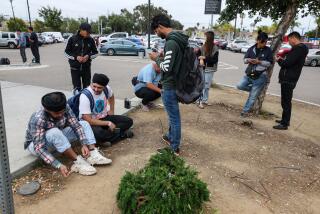PHONE’S UP : O.C. firm uses new 1-900 Pacific Bell number to spread word on surf
- Share via
At the crack of dawn Friday, hundreds of surfers dialed a Huntington Beach company trying to get a line on the gnarliest swells and raddest rides from San Francisco to San Diego.
Could this be the latest wave in telecommunications? Pacific Bell hopes so. And so does Surfline Inc., the firm that this week became the first to provide information over Pacific Bell’s new “900” telephone service.
For consumers, the principle behind 900 service is simple: If you need information, you dial an 11-digit number (they all begin 1-900) to find out, for a fee, what you want to know.
A call to Surfline costs from 85 cents to $2, depending on the type of information requested, but under state regulatory rules the charges can run as high as $20.
In principle, 900 numbers work the same way as the telephone industry’s better-known “976” services, which have gained notoriety for their so-called dial-a-porn offerings.
But there is a key difference: When parents want to prevent their children from calling 976 numbers offering sexually explicit messages, they have to shut their phone’s access to all 976 numbers.
With 900 service, Pacific Bell will assign dial-a-porn firms phone numbers with special prefixes and then selectively block that type of service for customers who don’t want it.
“With the new 1-900 service, it will be really easy to turn off ‘dial-a-porn lines,’ ” said Pacific Bell spokeswoman Linda Bonniksen.
“It’s designed to stop the problem of kids calling these lines and then parents being surprised by the bill.”
Although experts consider 900 dialing the nation’s fastest-growing phone service, it has been around for some time. Telephone customers, for instance, used 900 lines to indicate who they thought was the winner in the 1980 Reagan-Carter presidential debates.
But the 900 services have come into their own only recently, said Mark Plakias, a telephone industry market analyst with Strategic Telemedia in New York.
American Telephone & Telegraph was the only provider of 900 service for years, but recently almost all of the nation’s long-distance companies have moved into the market.
“In the last nine months we’ve seen a tidal wave of activity,” said Plakias.
Pacific Bell, Plakias noted, is the first local phone company to enter the business. “With PacBell we’re seeing the market muscle of a local company go against a national carrier,” he said.
Pacific Bell is betting that it has introduced a service that will boost its revenue by attracting hundreds of companies with information, entertainment or services to sell over the phone.
For their part, Surfline owners are wagering that the 900 service will expand the market for their tape-recorded wave reports and forecasts beyond the thousands of surfers who already use the firm’s “976-SURF” phone line. The company, like many others with 976 lines, believes it has been hurt by the phone “blocking” directed against dial-a-porn businesses.
Started on a shoestring in 1985 by Craig Matsuoka, David Wilk and Jerry Arnold, Surfline attracted over a million calls last year on its 976-SURF switchboard from California and Florida surfers.
For Surfline, Pacific Bell and the entire telecommunications industry, the stakes are high.
Consumers spent about $350 million on 976 and 900 numbers last year, and experts expect that number to grow to more than $3 billion by 1992.
“California is viewed in the telecommunications industry as the model for the 1990s,” Plakias said.
“A lot of companies will be watching PacBell to see how they do with this.”
More to Read
Inside the business of entertainment
The Wide Shot brings you news, analysis and insights on everything from streaming wars to production — and what it all means for the future.
You may occasionally receive promotional content from the Los Angeles Times.










